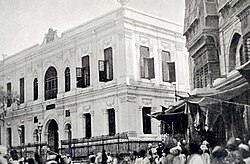| Al Hamidiyah Palace | |
|---|---|
| قصر الحميدية | |
 Hamidiyah Building during Ottoman rule, 1888 Hamidiyah Building during Ottoman rule, 1888 | |
| Alternative names | Al Hamidiyah Building |
| General information | |
| Status | Demolished |
| Architectural style | Neoclassical Ottoman |
| Location | Ajyad, Mecca, Saudi Arabia |
| Named for | Sultan Abdul Hamid II |
| Completed | 1885 |
| Demolished | 1957 |
| Known for | Proclamation of the Kingdom of Saudi Arabia |
Al-Hamidiyah Palace (Arabic: قصر الحميدية, romanized: Qasr al-Ḥamīdīah) or al-Hamidiyah Building (Arabic: مبنى الحميدية, romanized: Mabnai al-Ḥamīdīah) was an Ottoman-era double storey government building in the Ajyad district of Mecca, Saudi Arabia. The building played a pivotal role in the country's modern history as it was the location from where Prince Faisal bin Abdulaziz announced the official establishment of Saudi Arabia on King Abdulaziz's behalf. Built by the-then Ottoman governor of Hejaz Osman Nuri Pasha in 1885, it was named after Sultan Abdul Hamid II. The structure was completely razed down in 1957 during the reign of King Saud in order to pave the way for the Grand Mosque's expansion.
Overview
The building was constructed upon the orders from then governor of Hejaz Osman Nuri Pasha in 1885 and was named after the Sultan of the Ottoman Empire, Abdul Hamid II. It served as the administrative headquarters for the affairs of Mecca. After the conquest of Mecca by Ibn Saud's forces in 1924, it served as the seat for several nascent government departments like the General Directorate of Public Security, Directorate of Knowledge and the Shoura Council.
In September 1932, Ibn Saud issued a royal decree that renamed the Kingdom of Hejaz and Nejd as the Kingdom of Saudi Arabia. He directed Prince Faisal bin Abdulaziz, the Viceroy of Hejaz to proclaim the unification on his behalf from al-Hamidiyah Palace.
Following the death of Ibn Saud in 1953, his son Saud ascended to the throne and one of the first decisions he made was to relocate all the government ministries to Riyadh. He built the al-Malazz neighborhood in Riyadh in the 1950s as a housing project for government employees before turning it into a full fledged district. As the building fell into disuse, it was demolished in 1957 as part of King Saud's project of Grand Mosque's expansion project.
References
- عبد العزيز, شافعي، حسين (2005). الاربطة في مكة المكرمة في العهد العثماني : دراسة تاريخية حضارية، 923-1334 ه/1517-1915 ؛ مراجعة عباس صالح طاشكندي [Al-Rabaat in Mecca during the Ottoman era: a historical and cultural study, 923-1334 AH/1517-1915. Reviewed by Abbas Saleh Tashkandi] (in Arabic). مؤسسة الفرقان للتراث الاسلامي،.
- "'Die H̱amīdijjah (von Othman Pascha erbautes Regierungsgebäude)'. Photographer: al-Sayyid ʻAbd al-Ghaffār [6r] (1/1)". Qatar Digital Library. 16 May 2014. Retrieved 25 November 2022.
- "دار الحكومة ( الحميدية )" [Government House (Hamidiyah)]. makkawi.com (in Arabic). Retrieved 28 November 2022.
- "الحميدية يتحول من مبنى مدرسي إلى ديوان حكومي". صحيفة مكة (in Arabic). 31 January 2016. Retrieved 28 November 2022.
- "مديرية المعارف من شطا إلى بن مانع .. وفي أجياد مكة بدأت الحكاية". صحيفة الاقتصادية (in Arabic). 9 January 2017. Retrieved 28 November 2022.
- التحرير, فريق (25 September 2020). "صورة نادرة للحظة خروج "المؤسس" من دار الحكومة بمكة.. عمرها 99 عامًا". صحيفة عاجل (in Arabic). Retrieved 28 November 2022.
- "المملكة العربية السعودية... قصة "إعلان التوحيد"". الشرق الأوسط (in Arabic). Retrieved 28 November 2022.
- "National Day... The golden annals that were never scripted". Saudigazette. 23 September 2022. Retrieved 22 November 2022.
- "حي الملز.. من صحراء إلى سكن للوزراء". صحيفة الاقتصادية (in Arabic). 8 February 2009. Retrieved 20 May 2021.
- Rahmaan, Anis Ur (2011). The Imperatives of Urban and Regional Planning: Concepts and Case Studies from the Developing World. Xlibris Corporation. ISBN 978-1-4653-3668-2.
- "The history of Makkah Grand Mosque's expansion". Arab News. 29 July 2020. Retrieved 28 November 2022.
Categories: